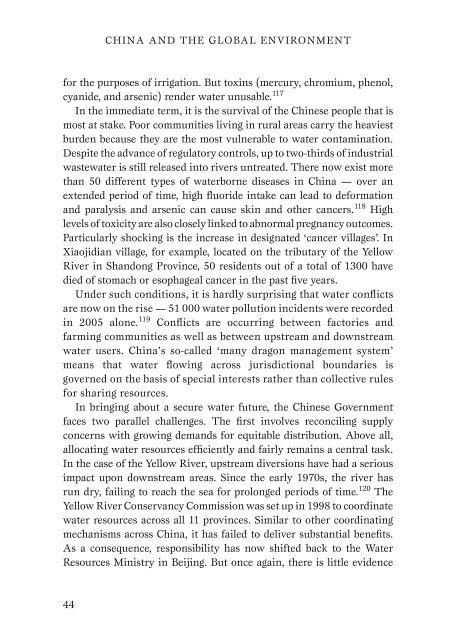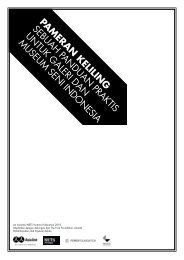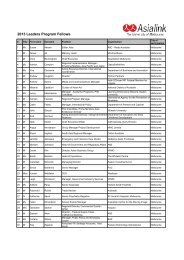China and the global environment - Asialink
China and the global environment - Asialink
China and the global environment - Asialink
Create successful ePaper yourself
Turn your PDF publications into a flip-book with our unique Google optimized e-Paper software.
CHINA AND THE GLOBAL ENVIRONMENTGOVERNING FROM ABOVE IN THE NEW CENTURYfor <strong>the</strong> purposes of irrigation. But toxins (mercury, chromium, phenol,cyanide, <strong>and</strong> arsenic) render water unusable. 117In <strong>the</strong> immediate term, it is <strong>the</strong> survival of <strong>the</strong> Chinese people that ismost at stake. Poor communities living in rural areas carry <strong>the</strong> heaviestburden because <strong>the</strong>y are <strong>the</strong> most vulnerable to water contamination.Despite <strong>the</strong> advance of regulatory controls, up to two-thirds of industrialwastewater is still released into rivers untreated. There now exist morethan 50 different types of waterborne diseases in <strong>China</strong> — over anextended period of time, high fluoride intake can lead to deformation<strong>and</strong> paralysis <strong>and</strong> arsenic can cause skin <strong>and</strong> o<strong>the</strong>r cancers. 118 Highlevels of toxicity are also closely linked to abnormal pregnancy outcomes.Particularly shocking is <strong>the</strong> increase in designated ‘cancer villages’. InXiaojidian village, for example, located on <strong>the</strong> tributary of <strong>the</strong> YellowRiver in Sh<strong>and</strong>ong Province, 50 residents out of a total of 1300 havedied of stomach or esophageal cancer in <strong>the</strong> past five years.Under such conditions, it is hardly surprising that water conflictsare now on <strong>the</strong> rise — 51 000 water pollution incidents were recordedin 2005 alone. 119 Conflicts are occurring between factories <strong>and</strong>farming communities as well as between upstream <strong>and</strong> downstreamwater users. <strong>China</strong>’s so-called ‘many dragon management system’means that water flowing across jurisdictional boundaries isgoverned on <strong>the</strong> basis of special interests ra<strong>the</strong>r than collective rulesfor sharing resources.In bringing about a secure water future, <strong>the</strong> Chinese Governmentfaces two parallel challenges. The first involves reconciling supplyconcerns with growing dem<strong>and</strong>s for equitable distribution. Above all,allocating water resources efficiently <strong>and</strong> fairly remains a central task.In <strong>the</strong> case of <strong>the</strong> Yellow River, upstream diversions have had a seriousimpact upon downstream areas. Since <strong>the</strong> early 1970s, <strong>the</strong> river hasrun dry, failing to reach <strong>the</strong> sea for prolonged periods of time. 120 TheYellow River Conservancy Commission was set up in 1998 to coordinatewater resources across all 11 provinces. Similar to o<strong>the</strong>r coordinatingmechanisms across <strong>China</strong>, it has failed to deliver substantial benefits.As a consequence, responsibility has now shifted back to <strong>the</strong> WaterResources Ministry in Beijing. But once again, <strong>the</strong>re is little evidenceto suggest that a centralised approach is more effective. In general,upstream users continue to benefit at a cost to <strong>the</strong>ir downstreamcounterparts. 121A second major challenge involves shifting from a supply-drivenmode of water governance to a conservation model that recognises<strong>the</strong> importance of conserving water ra<strong>the</strong>r than simply rediverting it.Today, in order to produce RMB10 000 of goods, Chinese industries useapproximately 100m 3 of water, ten times more than <strong>the</strong> internationalst<strong>and</strong>ard. Up to 65 per cent of <strong>China</strong>’s water is used for agriculturalpurposes, although irrigation is no more wasteful than in many o<strong>the</strong>rcountries. As noted by Kenneth Pomeranz, ‘limited supplies make wastea more pressing problem.’ 122 And correcting quality <strong>and</strong> wastage issuesis part of <strong>the</strong> answer to dealing with water shortages. 123There are signs that a conservationist approach may be ga<strong>the</strong>ringmomentum. Fixing leaky pipes, relining irrigation ditches, orinstalling drip irrigation can make a difference depending on <strong>the</strong>local conditions. However, this kind of approach st<strong>and</strong>s in starkcontrast to <strong>the</strong> overwhelming emphasis placed upon infrastructuraldevelopment. A continuing reliance upon large-scale engineeringprojects that pay inadequate attention to <strong>the</strong> <strong>environment</strong>al <strong>and</strong>human costs involved is one of <strong>China</strong>’s most enduring legaciesaffecting its <strong>environment</strong>al future.Symbolic in this regard is <strong>the</strong> south–north water transfer scheme(nanshui beidiao) that aims to alleviate flooding in <strong>the</strong> south <strong>and</strong>water scarcity in <strong>the</strong> north by diverting water from <strong>the</strong> Yangtze to <strong>the</strong>North <strong>China</strong> Plain. The scheme was officially approved by <strong>the</strong> StateCouncil in 2002. Three planned routes have been designed to connect<strong>the</strong> Yangtze with <strong>the</strong> Huang, Huai, <strong>and</strong> Hai Rivers. Construction isnow underway on <strong>the</strong> eastern route that brings water from <strong>the</strong> lowerYangtze in Jiangsu Province to Tianjin city on <strong>the</strong> coast. The middleroute runs between <strong>the</strong> Three Gorges in Sichuan <strong>and</strong> Beijing. And <strong>the</strong>western route, yet to begin construction, aims to redirect water from<strong>the</strong> Yarlong Tsangpo, Dadu, Tongtian <strong>and</strong> Jinsha Rivers into <strong>the</strong> YellowRiver. Looming problems include large-scale soil salinisation, pollutedsewage water intrusion, <strong>and</strong> adverse effects upon aquatic life along <strong>the</strong>4445










